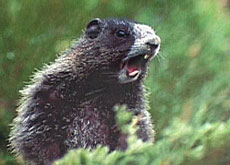Marmots find sanctuary in Swiss reserve

Following in the footsteps of the United Nations, an international family of the four-legged variety is making Switzerland its home.
Marmots from around the world are being brought together in a unique experiment aimed at increasing understanding of the rodents.
By the end of September there will be around 32 marmots from seven different species living in “Marmot Paradise” on the summit of Rochers-de-Naye (2,300m), which towers over the lakeside town of Montreux.
The project is the brainchild of Jean-Marc Forclaz, technical director of Golden Pass Railways.
He believes the marmot study centre and reservation – the only one of its kind in the world – will provide a mine of information concerning the habits of the rodents, about whom so little is known.
Forclaz says his main aim is to attract more passengers for the train service, which runs from Montreux to the top of the mountain.
Natural habitat
However, he admits to a deep affection for the creatures, born of years of walking in the Swiss Alps and observing them in their natural habitat.
The company’s cogwheel steam train is even painted with marmots to get passengers in the mood for communing with the animals.
Forclaz first came up with the idea in 1999, and had to win the approval of the World Wide Fund for Nature, Pro Natura and the Animal Protection Society before the project could be developed.
Planning permission for the reservation and study centre was granted in 2000, and construction began last year.
Forclaz initiated Internet contact with marmot biologists from all over the world, who offered information and specimens for the enclosures.
It was important to ensure the marmots could not escape, and that different species were not able to mix and mate.
Each species has its own enclosure of up to 400 square metres, bordered above and below ground by rock so that they cannot dig their way out.
Underground world
Mechanical diggers were used to bore through rock and to make the burrows the required three metres in depth.
At the moment there are seven enclosures, with a glass viewing chamber for the Swiss species of Alpine marmots.
Visitors can walk through tunnels, which provide a better view of the marmots’ underground world.
There are microphones and infrared cameras in the main burrows, where marmots sleep when it’s raining outside.
The images are relayed to video screens inside the study centre, where members of the public can observe the animals during their brief periods of wakefulness.
Also in the study centre, visitors can watch films showing marmot fathers trying to expel their sons from the burrows.
Interactive displays recreate the different marmot emergency calls, and show what the babies look and sound like when they are born.
And there’s also a touch of humour: a changeable mirror gives you an idea of how much weight marmots lose during hibernation.
Missing marmots
The path to marmot contentment has not been an easy one. A few of the animals went missing at Zurich airport, following a flight from Russia.
A search party was set up and the marmots were eventually traced to a vet’s office, where they were sitting in a cage without any importation and immunisation papers.
After sleeping through the winter in a chalet near Caux, another three marmots were transported up to the top of Rochers-de-Naye.
“At the start of the transportation we had three marmots in the cage,” remembers Forclaz.
“But there was a big surprise when they arrived at the summit and there were five marmots including two babies. Forty days later they came out [of the burrow] and they are now playing in the park.”
Size of cats
Marmots – known as groundhogs or woodchucks in the United States – are rodents, closely related to both ground squirrels and prairie dogs.
They are about the size of a domestic cat and are only found in the Northen Hemisphere.
Their diet consists mainly of flowers, grass and, occasionally, insects. Keepers top up their local grass feed with vegetables, fruit and dried food.
There are 14 different species altogether and their habits vary. The common US groundhog lives alone, while some species sleep with their families in the main burrow, probably to keep warm.
In some parts of America, they are used to predict the weather, and there is a US holiday named after them: Groundhog Day.
Prized for their meat
In other parts of the world, marmots are prized for their high protein meat.
Mongolians have developed elaborate hunting rituals, wearing “Playboy” ears to get closer to their prey, or dancing and swirling yaks’ tails to attract the marmot’s attention so they can get a better shot.
In the former Soviet Union, marmots are used for fur, medicine and food. Some 30 years ago, the Russians almost slaughtered the rodents to extinction, fearing they carried the plague.
Marmot biologists have started meeting every few years to pool information and ideas, based on their own research. The first international meeting of this kind was in Italy in 1991.
The next large conference will be in Montreux from September 15-17. One of the visiting scientists from Uzbekistan will bring along a new species for the reservation – the Marmota Caudata, which is coloured golden or red and has a long tail.
He will join fellow marmot experts from Russia, the United States and Switzerland.
swissinfo, Julie Hunt
Marmots only mate one day a year when the female is fertile, and live for about 14 years.
It is very difficult to distinguish the male from the female.
Females breed every second year and have up to five offspring.
During hibernation, their body temperature drops to a few degrees Celsius.
Marmots weigh 30 grammes at birth and 150 grammes after ten days.
Marmots from around the world have found a new home on top of a Swiss mountain where their every move is being watched in a unique experiment.
swissinfo met the creator of the reserve, Jean-Marc Forclaz, and visited the study centre where the mysterious habits of this lesser-known rodent are being exposed to the public.

In compliance with the JTI standards
More: SWI swissinfo.ch certified by the Journalism Trust Initiative









You can find an overview of ongoing debates with our journalists here . Please join us!
If you want to start a conversation about a topic raised in this article or want to report factual errors, email us at english@swissinfo.ch.